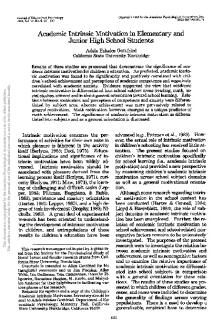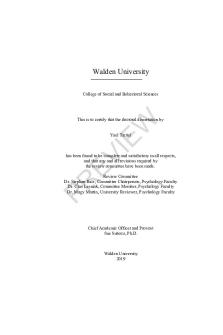The impact of intrinsic motivation PDF

| Title | The impact of intrinsic motivation |
|---|---|
| Course | Leadership Competencies in Nursing and Healthcare |
| Institution | Walden University |
| Pages | 7 |
| File Size | 143.9 KB |
| File Type | |
| Total Downloads | 37 |
| Total Views | 182 |
Summary
Mandatory assignment plus solution...
Description
Running head: THE IMPACT OF INTRINSIC MOTIVATION
1
Assignment: The Impact of Intrinsic Motivation Reflect for a moment on your nursing career. About what are you most passionate? When do you feel you are at your best? What brings you the greatest satisfaction in your work? Positive feelings in the workplace are usually fueled by intrinsic motivators: healthy relationships, meaningful purpose, competence, choice, and progress. As a nurse manager, it is helpful to recognize what motivates you to perform well in your own job. You should also take time to understand the motivations of employees. By speaking to staff about their interests and professional goals, nurse managers can build relationships and thus provide appropriate motivators. For this Assignment, you examine your personal work experiences to determine which of the five intrinsic motivators are more influential in shaping your positive feelings about the workplace. To prepare
Reflect on your work history, from your first job to your current employment. Select one time period or situation in which you felt professionally happy, motivated, and fulfilled in your job. What do you remember most about this time period? What are, or were, the various personal and professional factors that helped to shape these feelings? Select one time period or situation in which you felt professionally unhappy, disengaged, and unfulfilled in your job. What do you remember most about this time period? What are, or were, the various personal and professional factors that caused these feelings? Review the selected pages from Chapter 7, “Coaching and Developing Others” in the course text, From Management to Leadership: Strategies for Transforming Health Care. Consider the potential influence of the five intrinsic motivators during your chosen time period or situation. o Which intrinsic motivators seem to resonate more with your own perceptions of job fulfillment? o Which motivators do you believe have greater influence on your professional well-being? Review the media, “Fostering a Positive Workplace.” How can nurse leaders use their awareness of the five motivators to engage and retain nursing staff?
Submit a 3- to 5-page paper in which you do the following:
Appraise a time when you have felt professionally fulfilled. Describe the setting, your job title, and the roles and responsibilities in which you were engaged. Identify your own key intrinsic motivators and explain how these were evident in this situation. Cite specific examples. Appraise a time when you have felt professionally unfulfilled. Describe the setting, your job title, and the roles and responsibilities in which you were engaged. Explain the motivator(s) that were absent and how this impacted your professional performance. Cite specific examples.
THE IMPACT OF INTRINSIC MOTIVATION
Discuss how you, as a nurse manager, might implement organization- or department-wide changes that would create an environment that engages staff through one or more intrinsic motivators.
Include a title page, introduction, summary, and 5 scholarly references and APA format.
2
THE IMPACT OF INTRINSIC MOTIVATION
3
Abstract/Summary This paper looks at periods of fulfilment for the author and describes the setting including the roles and responsibilities during this period. The author identifies the key intrinsic motivators and explain how they were evident in the described situation citing specific examples. The author conversely looks at the period that they felt professionally unfulfilled describing the setting and the intrinsic motivators that were lacking. The paper finishes off with the author describing changes that can be created in the workplace to create a culture of engagement in the workplace.
THE IMPACT OF INTRINSIC MOTIVATION
4
Introduction According to Muha and Manion (2010), the management in any organization are responsible for creating positive environment that will encourage employee engagement and performance success in their various departments and the organization as a whole. The presence of intrinsic motivation is important in the engagement of employee through a creation of passion for work within the employees. Different employees have different intrinsic motivators i.e. what makes them look forward to coming to work every morning and doing the work to their best ability. Manion (2011) lists five intrinsic motivators for employees as: healthy relationships, choice, progress, competence and meaningful purpose. Professionally Fulfilled Period The time when I felt the most professionally fulfilled was a few years ago, when I was working as a staff nurse at a certain health facility in the high dependency unit (HDU). My primary duties, during this period, involved offering primary care to the high dependency patients but there were also times when I was required to carry out difficult procedures that I had no prior experience in. I therefore had to challenge myself by stepping out of my comfort zone to perform the procedures and as a result build my experience. The facility I worked for also had a culture of encouraging staff to further their knowledge and education by offering courses on critical care, which I opted for. One key intrinsic motivator for me during this period was that of progress resulting in achievement. I was motivated by the ability to complete those challenging procedures and courses successfully. For example when I completed the critical care course successfully, I was more than willing to take on more challenging responsibilities in the workplace.
THE IMPACT OF INTRINSIC MOTIVATION
5
One other key intrinsic motivator for me during this period was healthy relationships resulting in social connectivity. Manion (2011) argues that higher intrinsic motivation in the workplace comes as a result of sense of connectivity and positive relationships. In my role in the HDU, I was able to develop several positive relationships with fellow nurses and even at times with patients. Examples were times when the nursing staff would help each other to take care of patients and have evenings out to catch up and share experiences. Professionally Unfulfilled period The time when I felt that I was not professionally fulfilled was also a few years back when I worked in the emergency department as a coordinator at a local community hospital. The responsibilities included, but were not limited to, determining admission status appropriately and daily review of patients’ records. During this period, my supervising manager who was accommodative and had an open door policy, was replaced with a manager who was not so friendly. The new manager was not very welcoming to concerns or suggestions by employees. The manager made rush decisions without caring how the decision would impact the employees under her supervision. For example she would change and allocate shifts without caring if an employee was comfortable working the allocated shift. The intrinsic motivator I felt was lacking during this period was choice and meaningfulness. I felt that I was not free to choose how to accomplish my work and that I was not contributing anything meaningful to the work environment. I did not have job satisfaction. According to Nantha (2013), there exists a positive correlation between intrinsic motivation and job satisfaction. This negativity from the new manager made everyone in the department fearful and were afraid of engaging each other in the workplace. As a result positive connectivity was
THE IMPACT OF INTRINSIC MOTIVATION also lacking in the workplace and a lack of healthy relationships between the manager and the employees. Strategies for Environment of Engagement According to Nantha (2013), through strong leadership by management, staff appreciation and positive cultures are developed resulting in engagement. Positive workplace environment in which the employees feel trusted, appreciated and valued depend on intrinsic motivators. Muha and Manion (2010) argue that a negative work environment contributes to stress aggravation in the health care system. Therefore, as a nurse manager, I would work to encourage healthy work relationships and positive connectivity so as to achieve a positive work environment in my department. Changes that I would create include having open-door policies meaning that the employees under my supervision know that I am available and open to their proposals, suggestions and concerns. I will also open communication lines so that employees in the department are always kept in the loop because, as Llopis (2012) argues, employees are fearful of the unknown and may not be welcoming to surprises. A positive work environment will make employees feel safe and secure and hence be more engaged. According to Zhang and Bartol (2010), empowering employees also has a positive influence on intrinsic motivation. I can create changes that have an effect on employee empowerment such as allowing them to make decisions that determine how they want to do their work without much interference from the nurse manager. The intrinsic motivator that is key here would be choice.
6
COACHING EMPLOYEES
8 References
Llopis, G. (2012). 5 powerful things happen when a leader is transparent. Forbes. Retrieved from http://www.forbes.com/sites/glennllopis/2012/09/10/5-powerful-things-happen-when-aleader-is-transparent/#27a3f8814895 Manion J. (2011). From Management to Leadership: Strategies for Transforming Health (3rd ed.). Leadership in Health Services, 24 (3). https://doi.org/10.1108/lhs.2011.21124caa.007 Chapter 7, “Coaching and Developing Others” Muha, T. M., & Manion, J. (2010). Using positive psychology to engage your staff during difficult times. Nurse Leader, 50-54. Retrieved from the Walden Library databases. Nantha, Y. S. (2013). Intrinsic motivation: How can it play a pivotal role in changing clinician behavior? Journal of Health Organization and Management, 27(2), 266-272. Retrieved from http://healthcareredux.com/wp-content/uploads/2013/07/Culture-Nantha.pdf Zhang, X., & Bartol, K. M. (2010). Linking empowering leadership and employee creativity: The influence of psychological empowerment, intrinsic motivation, and creative process engagement. Academy of management journal, 53(1), 107-128....
Similar Free PDFs

Impact of ICT in the Society
- 3 Pages

Resarch 2 The Impact of Wages
- 11 Pages
Popular Institutions
- Tinajero National High School - Annex
- Politeknik Caltex Riau
- Yokohama City University
- SGT University
- University of Al-Qadisiyah
- Divine Word College of Vigan
- Techniek College Rotterdam
- Universidade de Santiago
- Universiti Teknologi MARA Cawangan Johor Kampus Pasir Gudang
- Poltekkes Kemenkes Yogyakarta
- Baguio City National High School
- Colegio san marcos
- preparatoria uno
- Centro de Bachillerato Tecnológico Industrial y de Servicios No. 107
- Dalian Maritime University
- Quang Trung Secondary School
- Colegio Tecnológico en Informática
- Corporación Regional de Educación Superior
- Grupo CEDVA
- Dar Al Uloom University
- Centro de Estudios Preuniversitarios de la Universidad Nacional de Ingeniería
- 上智大学
- Aakash International School, Nuna Majara
- San Felipe Neri Catholic School
- Kang Chiao International School - New Taipei City
- Misamis Occidental National High School
- Institución Educativa Escuela Normal Juan Ladrilleros
- Kolehiyo ng Pantukan
- Batanes State College
- Instituto Continental
- Sekolah Menengah Kejuruan Kesehatan Kaltara (Tarakan)
- Colegio de La Inmaculada Concepcion - Cebu













